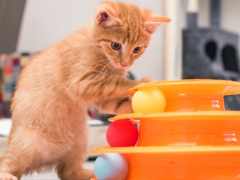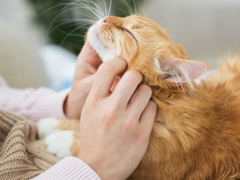
Anna Krivitskaya / Shutterstock.com
Sudden blindness in cats is very worrying for both you and your cat. You may have noticed your cat behaving strangely, vocalizing, bumping into things, or having trouble finding their food bowl. Some cats become visibly distressed, while others may act withdrawn or reclusive as if they’re afraid to move.
It is quite rare for cats to go blind overnight. Instead, the blindness has usually been progressing over some time, meaning they have been able to adapt. Cats are such masters at this that you may not have noticed any changes until the last bit of vision disappears, and they can no longer compensate. This is when their behavior can change dramatically, and they seem to go suddenly blind.
There are many causes of sudden blindness in cats, but only a few that are common. Let’s walk through the top five causes of sudden blindness in cats, how it is diagnosed, and treatments.
Top Five Common Causes of Sudden Blindness in Cats
1. Hypertension (High Blood Pressure)

Monitoring blood pressure every 6-12 months in cats over ten years old can detect high blood pressure before it causes a problem. David Herraez Calzada / Shtterstock.com
Hypertension is the most common cause of sudden blindness in cats—especially older cats. Sadly, high blood pressure often goes undiagnosed until it causes a problem.
Over time, pressure builds up in the small vessels at the back of the eye, causing them to burst and bleed. Some cats will also experience bleeding in the front of the eye, which you might notice at home. This pressure build-up can also lead to detachment of the retina—the layer of light-sensitive cells at the back of the eye that enables them to see. Retinal detachment leads to rapid blindness.
Cats with retinal detachment usually have behavior changes and widely dilated, reflective pupils. The condition is easily diagnosed by looking in the back of the eye using an ophthalmoscope. With rapid treatment of high blood pressure, cats can regain some vision. But it depends on the underlying issues, and how long the retina was detached.
High blood pressure is linked to important conditions like chronic kidney disease and hyperthyroidism. The earlier it is picked up and treated, the less likely it is to cause serious consequences such as blindness. As a result, I recommend blood pressure checks every 6–12 months in cats over ten years old.
2. Glaucoma
Glaucoma in cats is when fluid in the eye builds up and is unable to drain. Fluid is normally produced and cleared away continuously to keep the eye inflated. When this process is blocked, the fluid can build up and cause increased pressure within the eye. This can damage the optic nerve, resulting in vision loss or blindness.
Primary (inherited) glaucoma is rare but does affect breeds such as Siamese, Burmese, and Persian cats. Secondary glaucoma is more common, occurring due to another condition such as uveitis, trauma, bleeding within the eye, or a tumor.
Cats with glaucoma often have a blueish tinge to the eye. It may also appear enlarged, red, or painful—and they may show signs of blindness. Glaucoma is an emergency, so you should seek veterinary care immediately. Quick treatment with eyedrops to reduce intraocular pressure can prevent further loss of vision.
3. Trauma
Trauma to the eye or head can lead to blindness in cats. The most common injuries I see are road traffic accidents (RTAs) and penetrating injuries to the cornea (such as a thorn or claw).
These injuries can cause bleeding in the eye (hyphema), rupture of the eye, retinal detachment, and brain injuries—which can all cause sudden blindness. They can also lead to other abnormalities (such as cataracts), which can cause blindness further down the line.
4. Cataracts

Cataracts cause a cloudy appearance of your cat’s pupils. Anna Krivitskaya / Shutterstock.com
A cataract on your cat’s eye is a condition where the lens becomes cloudy or opaque, blocking light from entering the eye. Importantly, this cloudiness only affects your cat’s pupil, not the whole eye.
If only a small part of the lens is affected, the impact on vision can be negligible. However, if the cataract affects the whole lens, it will cause complete blindness in that eye.
Cataracts can affect one or both eyes. They are rarer in cats than in dogs or people and most often occur after trauma to the eye. But they can also be caused by chronic uveitis, glaucoma, radiation therapy, and exposure to some drugs or toxins.
It is possible to perform cataract surgery in cats, removing the damaged lens and replacing it with an artificial one.
5. Retinal Degeneration
Cats can suffer from retinal degeneration, where the retina degenerates over time, leading to a loss of vision and eventually blindness. This usually happens slowly, meaning cats can adapt to the loss of sight (until total blindness occurs). However, more rarely, it can happen suddenly.
Signs your cat may have retinal degeneration include dilated, hyper-reflective pupils alongside behavioral signs of blindness. However, it can only be diagnosed by a veterinarian looking at the back of the eye with an ophthalmoscope. Conditions that can cause retinal degeneration include:
- Taurine deficiency: Cats require taurine in their diets. This must be present in all balanced, commercial diets. However, can be lacking in home-cooked diets or cats fed on dog food.
- Enrofloxacin exposure: Enrofloxacin (brand name Baytril) is an antibiotic that can rarely cause retinal degeneration in cats. This is usually due to overdose or prolonged treatment but can occasionally occur as a side effect. Vision should improve when the drug is stopped, but damage can be long-lasting.
Uncommon Causes of Sudden Blindness in Cats
There are many reasons why a cat might appear to become suddenly blind. Hypertension is by far the most common, with the other common conditions described above. But there are also rarer causes to be aware of, including infectious diseases, brain disorders, cancer (such as lymphoma), optic neuritis, complications from eye surgery, and inherited conditions.
If you are worried about your cat’s vision, bring them to your veterinarian for a thorough ophthalmic examination. You may then be referred to a specialist for treatment.
Diagnosis of Sudden Blindness in Cats

Your veterinarian can check the structures inside your cat’s eye using an ophthalmoscope. guys_who_shoot / Shutterstock.com
Although there are many tests I perform as a veterinarian, the changes you notice at home are the most important indicator of a change in your cat’s vision. You might have noticed:
- Reduced confidence: Cats with blindness often restrict themselves to a small safe space, such as one room. They may not want to jump down off things, even if they were able to jump up there fairly easily.
- Walking around edges: Cats with poor vision will use their whiskers and other senses to guide themselves around the edge of rooms or furniture but may not venture into open spaces.
- Bumping into things: While bumping into things can be a sign of sudden blindness, it can also occur with long-term vision loss when there is a change in their normal layout, such as furniture being moved around. This can mimic sudden blindness but is actually a case of suddenly perceived blindness.
- Increased vocalization: Sudden blindness can make your cat distressed or disorientated, leading to yowling or crying.
- Changes in the appearance of their eyes: Conditions resulting in blindness often cause changes to the eyes. It may appear cloudy, or the pupil may be very wide and reflective.
Any change in your cat’s vision is concerning and warrants a full ophthalmic examination with your veterinarian. This will include a visual exam and some basic checks for vision and reflexes of the eyes.
Your veterinarian will then perform a detailed examination using an ophthalmoscope. This allows them to look at all the structures inside your cat’s eye, including the lens and retina. If glaucoma is suspected, they will measure the pressure within your cat’s eye using an instrument called a tonometer. In some cases, your cat may need a referral to a specialist veterinary ophthalmologist.
As high blood pressure is the leading cause of blindness in cats, your cat’s blood pressure should also be checked. If your cat is very stressed this may be falsely elevated, so you might need to bring them back another time when they are more relaxed.
Treating Sudden Blindness in Cats
Whatever the cause of your cat’s blindness, quick identification and treatment of the problem is key to saving your cat’s eyesight.
Treatment will depend on the underlying cause. This could include liquid or tablets to reduce your cat’s blood pressure, or eye drops to reduce pressure within the eye. If your cat’s blindness is related to their diet or a medication they’re taking, then stopping these can help.
With the right treatment, sudden blindness can be reversible. But in many cases, your cat may have permanent changes to their sight.
While sudden vision loss can be very distressing for your cat at first, most cats adapt remarkably well to loss of vision and go on to lead happy lives.
Frequently Asked Questions
Why is my cat suddenly going blind?
There are many reasons why cats can go blind suddenly, but the most common is high blood pressure. This causes the small blood vessels at the back of the eye to burst or bleed and can lead to retinal detachment and blindness. Other causes include glaucoma, trauma, cataracts, and retinal degeneration.
Is sudden blindness in cats reversible?
Depending on the cause, sudden blindness in cats can be reversed with the right treatment if it is given quickly. This might include tablets or liquids to reduce blood pressure, or eye drops to relieve pressure within the eye. However, in many cases, there will be some lasting damage to your cat’s vision.
How do you look after a blind cat?
Top tips for caring for a blind cat:
-
McLellan, G. J., & Miller, P. E. (2011). Feline glaucoma—a comprehensive review. Veterinary Ophthalmology, 14(s1), 15–29.
-
Mitchell, N. & Eye Vet. (n.d.). Irish Veterinary Journal Volume 63 Number 12. In Irish Veterinary Journal (Vol. 63, Issue 12, pp. 760–762).
-
Rowe, L. (2019, October 6). Blindness | International Cat Care. International Cat Care.







